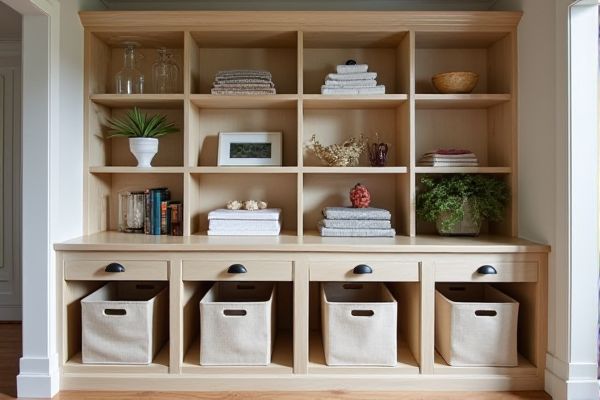
Open cubbies offer easy visibility and quick access to your items, making organization simple and efficient, while closed bins protect belongings from dust and provide a tidier, more streamlined appearance. Discover which storage solution best suits your needs by reading the rest of the article.
Table of Comparison
| Feature | Open Cubbies | Closed Bins |
|---|---|---|
| Visibility | High - Items easily seen and accessed. | Low - Items hidden, requiring opening to view contents. |
| Protection | Minimal - Exposed to dust and damage. | High - Enclosed, protects from dust and damage. |
| Organization | Moderate - Easy to organize visually. | High - Items neatly stored and separated. |
| Space Efficiency | Varies - Depends on item size and arrangement. | Optimized - Stackable and compact storage. |
| Accessibility | Quick access, no barriers. | Slower access, requires opening bin. |
| Best Use | Showcasing items, frequently used objects. | Long-term storage, clutter reduction. |
Introduction to Storage Solutions: Open Cubbies vs Closed Bins
Open cubbies provide easy access and visibility, making them ideal for frequently used items and quick organization in spaces like classrooms or workshops. Closed bins offer dust protection and concealment, perfect for storing seasonal belongings or items needing secure containment. Choosing between open cubbies and closed bins depends on the balance between accessibility and protection requirements.
Design Aesthetics: Visual Appeal of Each Option
Open cubbies offer a minimalist, airy design that enhances spatial visibility and display opportunities, creating an inviting atmosphere. Closed bins provide a sleek, uniform look that conceals clutter and maintains a clean, streamlined aesthetic. Your choice will significantly impact the room's visual appeal by balancing openness with orderliness.
Accessibility: Ease of Reaching and Organizing Items
Open cubbies provide quick and effortless accessibility, allowing you to easily see and reach items without any barriers, which speeds up organization and retrieval. Closed bins protect belongings from dust and clutter, but require opening lids or doors, making access slightly less immediate. For frequent use and easy organization, open cubbies enhance convenience and visibility, while closed bins offer better protection and a tidier appearance.
Space Optimization: Maximizing Storage Efficiency
Open cubbies maximize space optimization by allowing easy access and visibility, which reduces clutter and encourages efficient organization. Closed bins provide a more streamlined appearance, protecting items from dust and making it easier to stack and maximize vertical storage. Your choice depends on whether prioritizing quick access or maintaining a tidy, dust-free environment best suits your storage needs.
Cleanliness and Maintenance: Keeping Spaces Tidy
Open cubbies promote easy access and quick cleanup by allowing visible storage, making it simpler to spot and remove clutter or dust. Closed bins protect contents from dirt and spills, reducing the frequency of deep cleaning and maintaining a neater overall appearance. Your choice depends on whether you prioritize effortless tidiness with open storage or enhanced cleanliness through enclosed protection.
Customization: Personalizing Your Storage
Open cubbies offer flexible customization by allowing easy access and visibility, ideal for frequently used items and quick organization. Closed bins enhance personalization with varied sizes, colors, and labels, providing a tailored appearance while protecting contents from dust and clutter. Combining both options maximizes storage efficiency by meeting diverse needs and aesthetic preferences in personalized spaces.
Safety and Child-Friendliness
Open cubbies provide easy access for children, promoting independence and quick organization but can pose safety risks with items falling out or being hard to contain. Closed bins offer better protection by securely storing toys and supplies, reducing the risk of accidents and keeping your space clutter-free and child-friendly. Choosing storage solutions based on your child's age and activity level ensures a safer environment tailored to their needs.
Versatility in Different Rooms and Uses
Open cubbies offer versatile storage for frequently accessed items in living rooms, playrooms, and entryways, allowing easy visibility and quick retrieval. Closed bins provide discreet organization for bedrooms, offices, and closets, protecting contents from dust and maintaining a tidy appearance. Combining open cubbies with closed bins enhances adaptability, accommodating diverse storage needs across multiple room types efficiently.
Cost Comparison: Budgetary Considerations
Open cubbies generally offer a more cost-effective storage solution due to simpler materials and construction, reducing initial expenses. Closed bins tend to be pricier because of added features like lids, locks, and durability enhancements that increase manufacturing costs. Budgetary considerations should weigh upfront affordability of open cubbies against the potential longer-term value and protection provided by closed bins.
Final Thoughts: Choosing Between Open Cubbies and Closed Bins
Open cubbies offer quick visibility and easy access, ideal for frequently used items, while closed bins provide dust protection and a cleaner appearance, suited for long-term storage. Consider the storage environment, item type, and aesthetic preferences when deciding between these options. Balancing accessibility with protection ensures optimal organization and maintenance of stored belongings.
 homyna.com
homyna.com